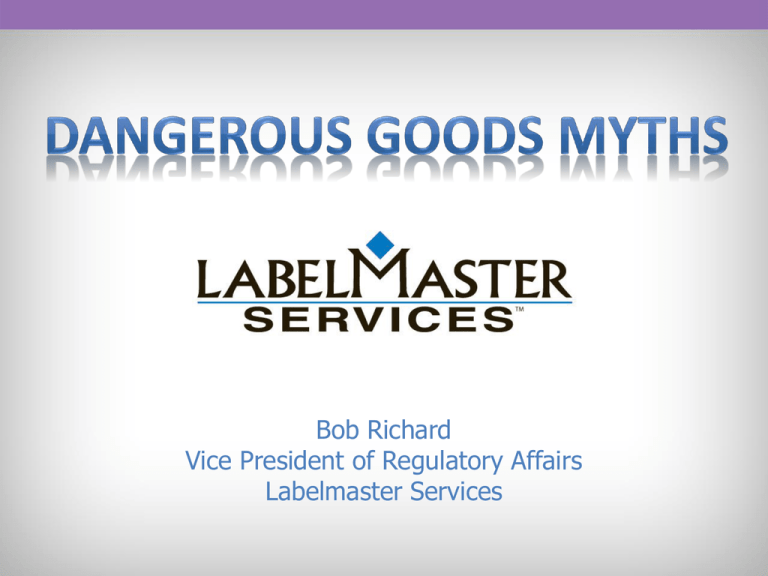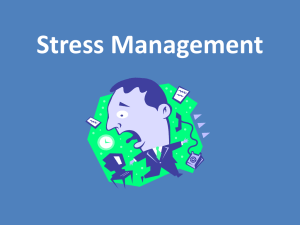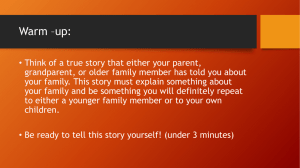Dangerous GOODs Myths
advertisement

Bob Richard Vice President of Regulatory Affairs Labelmaster Services DANGEROUS GOODS TRUTHS, MYTHS AND MISPERCEPTIONS • What are some common DG myths, truths and misperceptions? • How do DG myths impact trainers? • How can we overcome them? • A prior regulator’s “gone to the dark side” perspective. • Can we change perspectives to enhance compliance? • How can we be proactive to enhance safety, compliance and work with regulators? DANGEROUS GOODS TRUTHS, MYTHS AND MISPERCEPTIONS Regulations • The transport regulations are harmonized. • The regulations are not complex. • The DG regulations are risk-based and datadriven. • All amendments are justified, necessary and practical. • Politics do not play a role in regulation development. DANGEROUS GOODS TRUTHS, MYTHS AND MISPERCEPTIONS Regulators • All regulators are created equal. • Regulators need to keep a distance from industry in order to prevent the perception of impropriety. • Regulators always have a thorough understanding of the regulations and agree on how they are interpreted. • The regulator is your friend. • Ross McLachlan is cool! DANGEROUS GOODS TRUTHS, MYTHS AND MISPERCEPTIONS Preventing incidents • All incidents, injuries and fatalities are preventable. • There are unlimited resources to address safety. • If an accident occurs, the regulations must be deficient. • More comprehensive regulations lead to enhanced compliance and safety. • No matter how hard we try, we will never be able to prevent all incidents. DANGEROUS GOODS TRUTHS, MYTHS AND MISPERCEPTIONS Training • Training can be left until the employee has been on the job for some time. • “Awareness” training is all that is needed (i.e. the need for function specific is not understood). • DGSAs, when required, should be able to do everything (including all classification work) to provide compliance to ADR/RID/ADN. • DGSAs automatically know about sea and air requirements. DANGEROUS GOODS TRUTHS, MYTHS AND MISPERCEPTIONS Consignors • Suppliers are always compliant so I don’t need to worry. • I can’t be held accountable if I reship dangerous goods that are not properly declared, marked, labeled, packed and documented. • The cost of compliance is too extreme…it is cheaper to pay the fines. • I give the shipment to the carrier and it is his job to make sure it is compliant. • It is okay to send small amounts by post unmarked. • SDS Section 14 provides everything I need for a transport classification. DANGEROUS GOODS TRUTHS, MYTHS AND MISPERCEPTIONS • SDSs stating “not regulated for transport” when the manufacturer really should have been saying “Class 3 PG II exempted for ground transportation in packages of 30 kg or less and inner packagings of 1 L or less.” Or "combustible liquid.” • Many shippers think that when using UN specification packagings, they just need to control the outer packaging to see if it meets the requirements of the PI. They often forget that inner packagings must be also tested... DG MYTH BUSTERS “I’m not really a dangerous goods shipper; I just send some stuff down the street to the body shop and the parts warehouse.” Requirements in the dangerous goods regulations apply to each person who transports dangerous goods or performs a transportation function. -9- DG MYTH BUSTERS “I just reuse the transport documents that I receive from the manufacturer to ship my stuff so I don’t need to recreate them.” The manufacturer is human and may or may not have a rigorous compliance program. - 10 - DG MYTH BUSTERS “I use contract personnel to package and ship my dangerous goods, I am not responsible to ensure they are trained.” This approach is misguided and leaves the contracting company open to significant liability. - 11 - DG MYTH BUSTERS “My competitors don’t comply so why should I comply with impractical and complicated requirements” It is not necessarily about the probability of getting caught although fines can be severe. Employee and public safety, corporate image and protecting your company from liability should be driving factors. You don’t want to be the poster child for non-compliance. - 12 - DG MYTH BUSTERS “Who writes this stuff? Can they really expect us to understand all of these burdensome requirements. How can we possibly be compliant?” It is true that the DG requirements are complex. Compliance is not easy. Companies need to work with regulators to simplify requirements and provide feedback to promote practical requirements that have the greatest impact to safety. - 13 - DG MYTH BUSTERS “I don’t have to worry I will just hand the shipment over to a freight forwarder who will assume all my responsibility.” Guess again! The forwarder is an AGENT of the shipper, and the shipper must make sure that certain information is communicated to the forwarder in a legible and verifiable manner (e.g. that a shipment contains “Engines, internal combustion not restricted as per SP A 70”). - 14 - DG MYTH BUSTERS “The regulations are ‘as is’ and always correct.” Shippers do not update the regulations annually or biannually (as required), do not incorporate addendums and corrigendums, and — this goes especially for the foreign language editions of the IATA DGR — forget that only the English edition is legally binding. - 15 - DG MYTH BUSTERS “Since I am shipping to the U.S., I just need to comply with the IMDG Code or ICAO TI.” Most shippers are not aware that their shipments must FULLY comply with the additional requirements in 49 CFR Part 171 Subpart C. They have neither a copy of 49 CFR on site nor are they aware of certain requirements, such as hazardous substances. - 16 - DG MYTH BUSTERS “It doesn’t matter what I do. The regulators won’t listen to me.” Not true. Regulators are human and while they have limited resources, most will readily listen and welcome proactive suggestions. - 17 - COMMON ENFORCEMENT ACTIONS • • • • • • • • Failure to train, improper training records Undeclared shipments Improper packaging, closure instructions, performance testing Hazmat improperly declared on shipping paper Packaging discrepancies Security plans -172.704(a) missing risk assessment, company responsibilities Labels and marks not properly applied (pre-printed label or mark dimensions) Unauthorized emergency response number THE NUMBER ONE MOST COMMON VIOLATION 172.704(d) Recordkeeping. The record shall include: (1) The hazmat employee’s name; (2) The most recent training completion date of the hazmat employee’s training; (3) A description, copy, or the location of the training materials used to meet the requirements in paragraph (a) of this section; (4) The name and address of the person providing the training; and (5) Certification that the hazmat employee has been trained and tested, as required by this subpart. The distinction between “a certificate” and “certification” is important: • It is not merely an indication that a person took somebody’s training class. • It is not a certification of what the employee did (took a class, passed an exam, etc.). • Rather, it’s a certification of what the employer has done: “the hazmat employee has been trained and tested, as required by the HMR.” EXAMPLE OF EMPLOYEE TRAINING RECORD • • • • • • • OTHER COMMON CAUSES OF VIOLATIONS Product returns. A company doesn't normally ship hazmat but has to return a product to a vendor. The trained employee called in sick. An untrained person was driving the forklift, marking the package, or performing some other hazmat function for which they weren’t certified. The shipment is not regulated by ground, but is by air. And because it “absolutely, positively had to get there quickly” in an effort to accommodate a customer, a company ends up with a $50,000 fine. The information from the manufacturer was just plain wrong (this happens more than you think). Many manufacturers are not familiar with any regulations other than ground shipping. The SDS was in error. In our estimation, more than 30% of the SDSs we review contain incorrect or incomplete information in “Section 14 – Transportation.” An employee was trained for a mode of transport other than the one used. The regulations had changed and the company didn't know it. An employee was trained 5 years ago; the regulations had changed since then (if it’s lithium batteries that may happen every year!). FEDERAL REGISTER SAFETY NOTICE AUGUST 30, 2011 | DOCKET #: PHMSA-2011-0162 SPECIAL PERMIT PACKAGES • Awareness and importance of adhering to requirements of Special Permits (SPs). • SPs are issued for different packaging alternatives or transportation issues not found in the 49 CFR. • Function-specific training requirements on SPs. • Non-compliance with SPs may have serious safety consequences. • “Shipper failure to comply: 3 lives lost during a vessel loading operation”. SP 11186 SP 11186 - ISO PORTABLE TANK IN TRANSPORTATION • Authorized a non-specification portable tank • ON DECK ONLY, per 49 CFR 176.76(g), for Cryogenic Liquids • Tank marked “SP 11186” - Tested every 5 yrs - Copy of SP at location of filling and on vessel - determine One Way Travel Time (OWTT) - OWTT on shipping paper - Record of tank pressure at ambient temp (start of trip, every 24 hours, at destination) • VIOLATIONS: Failed to comply with SP; Not listing SP number on BOL; not providing copy of SP to vessel; no function specific training for SP; no external inspection of Emergency Relief Devices; not listing OWTT and temp on BOL. • RESULT: 3 LOST LIVES!!!!!! INVESTIGATION • Container put below deck. • Pressure relief device’s (PRD) safety wire was cut and valve closed. • Two of the three PRDs did not function during investigation testing. • Over-pressurized. • Argon gas leaking below deck. • 3 men went in to investigate and never came back!!! INVESTIGATION • Choose the right carrier and form a relationship • Plan ahead and develop specific written protocols and SOPs • Understand the regulations (consultants can help) • Train employees and establish corporate responsibility • Ensure paperwork is correct • Choose the appropriate packaging • Develop a security plan • Have a plan for incidents and unexpected events • Conduct audits and identify compliance gaps WHAT CAN DGTA MEMBERS DO? • • • • • • Engage regulators. Be proactive. Be ahead of regulation changes and provide input. Represent the views of trainers worldwide. Enhance the quality and clarity of regulations. Highlight the importance of compliance. NEED COMPLIANCE ASSISTANCE? Bob Richard Vice President of Regulatory Affairs Labelmaster Services Phone: (773) 540-0837 E-mail: bob.richard@alc-net.com Web: www.labelmasterservices.com Consulting and Assessment Services for Hazardous Material Transport and Shipping








